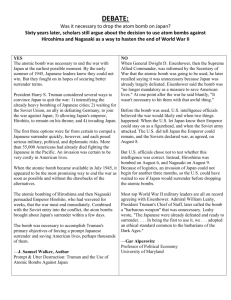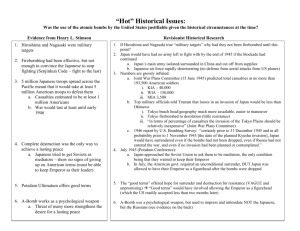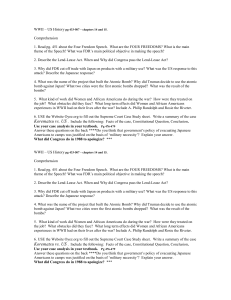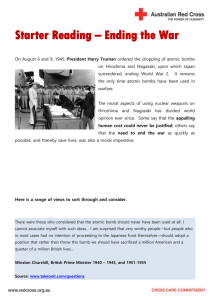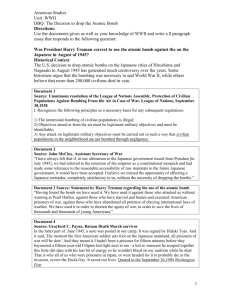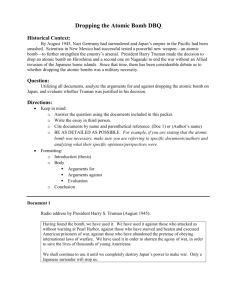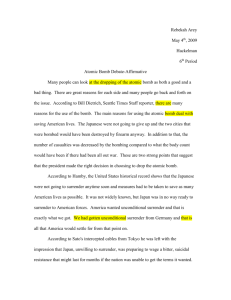DBQ
advertisement
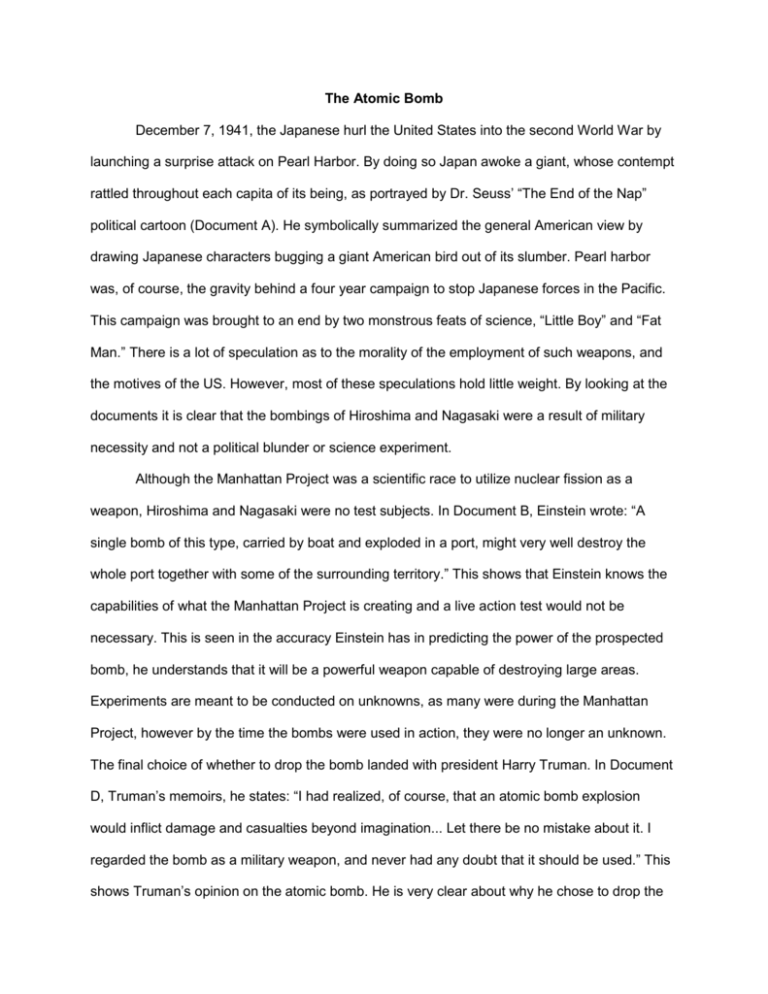
The Atomic Bomb December 7, 1941, the Japanese hurl the United States into the second World War by launching a surprise attack on Pearl Harbor. By doing so Japan awoke a giant, whose contempt rattled throughout each capita of its being, as portrayed by Dr. Seuss’ “The End of the Nap” political cartoon (Document A). He symbolically summarized the general American view by drawing Japanese characters bugging a giant American bird out of its slumber. Pearl harbor was, of course, the gravity behind a four year campaign to stop Japanese forces in the Pacific. This campaign was brought to an end by two monstrous feats of science, “Little Boy” and “Fat Man.” There is a lot of speculation as to the morality of the employment of such weapons, and the motives of the US. However, most of these speculations hold little weight. By looking at the documents it is clear that the bombings of Hiroshima and Nagasaki were a result of military necessity and not a political blunder or science experiment. Although the Manhattan Project was a scientific race to utilize nuclear fission as a weapon, Hiroshima and Nagasaki were no test subjects. In Document B, Einstein wrote: “A single bomb of this type, carried by boat and exploded in a port, might very well destroy the whole port together with some of the surrounding territory.” This shows that Einstein knows the capabilities of what the Manhattan Project is creating and a live action test would not be necessary. This is seen in the accuracy Einstein has in predicting the power of the prospected bomb, he understands that it will be a powerful weapon capable of destroying large areas. Experiments are meant to be conducted on unknowns, as many were during the Manhattan Project, however by the time the bombs were used in action, they were no longer an unknown. The final choice of whether to drop the bomb landed with president Harry Truman. In Document D, Truman’s memoirs, he states: “I had realized, of course, that an atomic bomb explosion would inflict damage and casualties beyond imagination... Let there be no mistake about it. I regarded the bomb as a military weapon, and never had any doubt that it should be used.” This shows Truman’s opinion on the atomic bomb. He is very clear about why he chose to drop the bomb. It wasn't some sick idea of experimentation. it wasn't out of curiosity for what would happen. He simply wanted to use the military technology he had available. Truman states that he understood that the casualties and damage would be catastrophic and that he wanted to use the bomb as a military tool, this shows that he was, in no way, performing an experiment on the Japanese, rather using what was available to end the war. The atomic bombs were not tests for observation, they were the catalysts of peace. The decision to drop the atomic bombs was surrounded in politics, but the decision was not a blunder. With the knowledge available at the time, the president made the correct choice in bombing Japan. This knowledge included the strong possibility of the Russians entering the Pacific Theater, siding with the Axis. In Document F, Dwight D. Eisenhower wrote: “I foresaw certain difficulties arising out of such participation [of the Russians in the Pacific Theatre] and suggested that... we ought not put ourselves in the position of requesting or begging for Soviet aid. It was my personal opinion that no power on earth could keep the Red Army out of that war unless victory came before they could get in.” (Doc. F) In the passage, Eisenhower explains the danger of Russian involvement in the war and thus, why a quick ending is beneficial. He does this by explaining that if Russian involvement in the Pacific Theatre became a definite, we would be in a compromising situation. The situation becomes compromising because the Soviets might enter the war siding with the Japanese and we would be stuck attempting to persuade, and beg, the Russians to help us instead. Eisenhower’s concern of having to beg the Soviets to join America’s side of the fight was no delusion, it was, in fact, a legitimate possibility that the Russians would side with Japan. Therefore, Truman’s decision to drop the atomic bombs was preventively beneficial, because it ended the conflict before it could become even worse. Herbert Feis, in Document G, brings up another possible political motive behind the decision. He explains that not only did the bombs bring the war to a quick end, they also might have improved the odds of a satisfactory peace. This shows another possible political advantage to using the atomic bombs. Such display of power could discourage the entitlement and ambition of opposing countries, effectively imbuing respect for a peaceful world order. Feis makes it a clear distinction that this is no sinister bullying of foreign policy by way of “atomic blackmail,” but rather a push towards achieving a “stable international order.” The use of the power granted to the US through our investment in scientific advancement was the right course of action, as it was able to accomplish many things, both preventative and immediate, that are selfishly beneficial to the United States. Little Boy and Fat Man were developed, constructed, transported, and detonated all in necessary compliance with the achievement of a victory with minimal American casualties. Had they not been used, the resulting casualties would have been far more than those at the hand of nuclear explosions. This is exactly the point raised by Henry L. Stimson in Document C. He states as follows, “In order to end the war in the shortest possible time and to avoid the enormous losses of human life, I felt that we must use the Emperor as our instrument to command and compel his people to cease fighting. The bomb seemed to me to furnish a unique instrument for that purpose.” This same document also states that the “total strength of the Japanese army was estimated at about 5,000,00 men.” This shows that the bomb was a necessity in preserving the lives of American soldiers. Had Truman decided to continue with traditional warfare, he still would have had a great deal of Japanese soldiers to conquer. According to the document, the Japanese had half of its army on its home islands, giving the US over 2,000,000 men to fight on Japanese soil. This scale of a campaign would, no doubt, drag the war out much longer, cost the United States great amounts of cash, and cause thousands more of our men to not come home. This being established, the alternative of dropping two bombs is favorable. However, some might argue the same as General H.H. Arnold in Document E. He argues that the Japanese were already at the brink of surrender, claiming they were severely weakened by our previous attacks. While it is true that the Japanese were severely weakened and on the verge of collapse, it is not certain that they would have surrendered. Waiting for Japan to crumble is a gamble. A gamble that involves a massive amount of lives, money and time. All of which were important. All of which were previously exhausted. The Japanese still had an army of men who were willing to fight, and waiting until they lost their team spirit risks both Russian involvement and US loss. The quicker, safer, and most efficient solution was to drop the bomb. It was a necessity, if the US was to win. Taking into account all of the documents presented, it becomes easy to understand the United State’s decision to unleash nuclear warfare on the Japanese was an essential part of ending a successful campaign in the most efficient manner. Although brutal, the infancy of nuclear warfare, in which these bombs were used, is child’s play in comparison to the potential killing power of the developed world's nuclear armies today. ‘Fat Man’ and ‘Little Boy’ were used in the pursuit of selfish preservation, an easy solution to multiple problems, however it is the hope of everyone that they never be used again. Sadly, the Cold War happened. An arms race that forced us to accomplish great things, while also expanding the world's atomic arsenal far beyond comfortable levels. Now, in moderately peaceful times, we need to understand the importance of self-disarmament and support the alleviation of the threat of instantaneous and absolute destruction.
